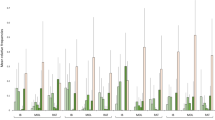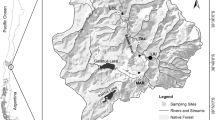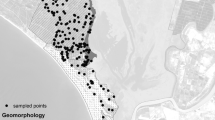Abstract
The free-floating American duckweed, Lemna minuta, is an invasive species now widespread in Europe. Yet, its impact on freshwater ecosystems has been poorly investigated. In this study, the effects of the presence of this invasive duckweed on water quality, and aquatic plant and invertebrate communities were evaluated in sites in Central Italy. Water chemical and physical factors and community descriptors were analyzed to identify these effects. Surveys were carried out across 17 paired aquatic sites. Site pairs were similar in microclimate, hydrogeology and water quality, but differed in relation to the presence/absence of L. minuta floating mats. In sites with mats, light and dissolved oxygen in water were negatively correlated with increasing mat coverage and thickness. The limited light and hypoxic conditions under mats inhibited plant growth and had a selective impact on the invertebrate community. Sites with L. minuta had aquatic communities with a lower plant taxa richness and a contrasting composition, compared with those in sites without. At sites with mats some plants were unaffected, but the majority of plant taxa documented at sites without Lemna were no present at sites with Lemna or were very rare (macroalgae, submerged rhizophytes). As for invertebrates, hypoxic-tolerant taxa dominated under mats (Ostracoda, Copepoda, Isopoda), whilst those more sensitive to oxygen depletion, or obligate herbivores, or those with a winged stage or swimming on water surface, were rare or absent (Ephemeroptera, Amphipoda, Chironomus, Notonecta). Lemna minuta mats presence was associated with alterations in the underlying aquatic ecosystem, severely threatening the conservation of these habitats. Active management strategies, including spread-prevention techniques, or mechanical removal combined with biological control, are required to conserve these habitats.




Similar content being viewed by others
References
Abdel-Tawwab M (2006) Effect of free floating macrophyte, Azolla pinnata R. Brown on water physico-chemistry, primary productivity, and the production of Nile Tilapia, Oreochromis niloticus (L.), and common carp, Cyprinus carpio L., in fertilized earthen ponds. J Appl Aquac 18:21–41. https://doi.org/10.1300/J028v18n01_02
Bramm ME, Lassen MK, Liborussen L et al (2009) The role of light for fish-zooplankton–phytoplankton interactions during winter in shallow lakes—a climate change perspective. Freshw Biol 54:1093–1109. https://doi.org/10.1111/j.1365-2427.2008.02156.x
Brendonck L, Maes J, Rommens W et al (2003) The impact of water hyacinth (Eichhornia crassipes) in a eutrophic subtropical impoundment (Lake Chivero, Zimbabwe). II. Species diversity. Fundam Appl Limnol 158:389–405. https://doi.org/10.1127/0003-9136/2003/0158-0373
Brix H (1993) Macrophyte-mediated oxygen transfer in wetlands: transport mechanisms and rates. In: Moshiri GA (ed) Constructed wetlands for water quality improvement. Lewis Publishers, London, pp 391–398
Campaioli S, Ghetti PF, Minelli A, Ruffo S (1999) Manuale per il riconoscimento dei macroinvertebrati delle acque dolci Italiane. Vol. II. Provincia Autonoma di Trento, Museo di Storia Naturale di Trento, p 484
Carpenter SR (1996) Microcosm experimentations have limited relevance for community and ecosystem ecology. Ecology 77:677–680. https://doi.org/10.2307/2265490
Carpenter SR, Stanley EH, Zanden MJV (2011) State of the world’s freshwater ecosystems: physical, chemical and biological changes. Annu Rev Environ Resour 36:75–99. https://doi.org/10.1146/annurev-environ-021810-094524
Ceschin S, Abati S, Leacche I, Iamonico D, Iberite M, Zuccarello V (2016a) Does the alien Lemna minuta show an invasive behaviour outside its original range? Evidence of antagonism with the native L. minor L. in Central Italy. Int Rev Hydrobiol 101(5-6):173–181. https://doi.org/10.1002/iroh.201601841
Ceschin S, Della Bella V, Piccari F, Abati S (2016b) Colonization dynamics of the alien macrophyte Lemna minuta Kunth: a case study from a semi-natural pond in Appia Antica Regional Park (Rome, Italy). Fundam Appl Limnol 188(2):93–101. https://doi.org/10.1127/fal/2016/0870
Ceschin S, Leacche I, Pascucci S, Abati S (2016c) Morphological study of Lemna minuta Kunth, an alien species often mistaken for the native L. minor L. (Araceae). Aquat Bot 131:51–56. https://doi.org/10.1016/j.aquabot.2016.01.005
Ceschin S, Abati S, Ellwood NTW, Zuccarello V (2018a) Riding invasion waves: spatial and temporal patterns of the invasive Lemna minuta from its arrival to its spread across Europe. Aquat Bot 150:1–8. https://doi.org/10.1016/j.aquabot.2018.06.002
Ceschin S, Abati S, Leacche I, Zuccarello V (2018b) Ecological comparison between duckweeds in Central Italy: the invasive Lemna minuta vs. the native L. minor. Plant Biosyst 152(4):674–683. https://doi.org/10.1080/11263504.2017.1317671
Ceschin S, Abati S, Traversetti L, Spani F, Del Grosso F, Scalici M (2019a) Effects of the invasive duckweed Lemna minuta on aquatic animals: evidence from an indoor experiment. Plant Biosyst. https://doi.org/10.1080/11263504.2018.1549605
Ceschin S, Sgambato V, Ellwood NTW, Zuccarello V (2019b) Phytoremediation performance of Lemna communities in a constructed wetland system for wastewater treatment. Environ Exp Bot 162:67–71. https://doi.org/10.1016/j.envexpbot.2019.02.007
Coughlan NE, Kelly TC, Jansen MA (2015) Mallard duck (Anas platyrhynchos)-mediated dispersal of Lemnaceae: a contributing factor in the spread of invasive Lemna minuta? Plant Biol 17(1):108–114. https://doi.org/10.1111/plb.12182
Crane K, Cuthbert RN, Dick JTA, Kregting L, MacIsaac HJ, Coughlan NE (2019) Full steam ahead: direct steam exposure to inhibit spread of invasive aquatic macrophytes. Biol Invasions 21:1311–1321. https://doi.org/10.1007/s10530-018-1901-2
Cronk JK, Fennessy MS (2001) Wetland plants: biology and ecology. CRC Press, Boca Raton
DAISIE (2009) Handbook of alien species in Europe. Springer, Berlin
Dale HM, Gillespie T (1976) Influence of floating vascular plants on diurnal fluctuations of temperature near water surface in early spring. Hydrobiologia 49:245–256. https://doi.org/10.1007/BF00014518
De Tezanos Pinto P, Luz A, O’Farrell I (2007) Influence of free-floating plants on the structure of a natural phytoplankton assemblage: an experimental approach. J Plankton Res 29(1):47–56. https://doi.org/10.1093/plankt/fbl056
Dejen E, Vijverberg J, Nagelkerke LAJ, Sibbing FA (2004) Temporal and spatial distribution of microcrustacean zooplankton in relation to turbidity and other environmental factors in a large tropical lake (Lake Tana, Ethiopia). Hydrobiologia 513:39–49. https://doi.org/10.1023/B:hydr.0000018163.60503.b8
Driever SM, Nes EH, Roijackers RMM (2005) Growth limitation of L. minor due to high plant density. Aquat Bot 81:245–251. https://doi.org/10.1016/j.aquabot.2004.12.002
Dudgeon D, Arthington AH, Gessner MO et al (2006) Freshwater biodiversity: importance, threats, status and conservation challenges. Biol Rev 81:163–182. https://doi.org/10.1017/S1464793105006950
Dussart G, Robertson J, Bramley J (1993) Death of a lake. Biol Sci Rev 5(5):8–10
Fontanarrosa MS, Chaparro G, de Tezanos Pinto P, Rodriguez P, O’Farrell I (2010) Zooplankton response to shading effects of free-floating plants in shallow warm temperate lakes: a field mesocosm experiment. Hydrobiologia 646:231–242. https://doi.org/10.1007/s10750-010-0183-1
Furlow BM, Hays KL (1972) Some influences of aquatic vegetation on the species and number of Culicidae (Diptera) in small pools of water. Mosq News 32(4):595–599
Giardini M (2004) Salvinia molesta DS Mitchell (Salviniaceae): seconda segnalazione per l’Italia (Lazio) e considerazioni sul controllo di questa specie infestante. Webbia 59:456–467. https://doi.org/10.1080/00837792.2004.10670778
Gratwicke B, Marshall BE (2001) The impact of Azolla filiculoides Lam. on animal biodiversity in streams in Zimbabwe. Afr J Ecol 38:1–4. https://doi.org/10.1046/j.0141-6707.2000.00284.x
Hamilton SK, Sippel SJ, Melack JM (1995) Oxygen depletion and carbon dioxide and methane production in waters of the Pantanal wetland of Brazil. Biogeochemistry 30:115–141. https://doi.org/10.1007/BF00002727
Howard GW, Harley KLS (1998) How do floating aquatic weeds affect wetland conservation and development? How can these effects be minimized? Wetl Ecol Manag 5:215–225. https://doi.org/10.1023/a:1008209207736
Hussner A (2012) Alien aquatic plant species in European countries. Weed Res 52:297–306. https://doi.org/10.1111/j.1365-3180.2012.00926.x
Iamonico D, Abati S, Iberite M (2010) Lemna minuta Kunth (Araceae) nel Lazio (Italia centrale): note morfologiche e osservazioni sui caratteri d’invasività. In: Proceedings of the 18th meeting forum natura mediterraneo on “Le specie aliene nel Mediterraneo”, 2010 March 20–21; Paliano, Italy 2010. https://www.naturamediterraneo.com/primoconvegnoNM/Iamonico_Iberite.pdf
Iberite M, Iamonico D, Abati S, Abbate G (2011) Lemna valdiviana Phil. (Araceae) as a potential invasive species in Italy and Europe: taxonomic study and first observations on its ecology and distribution. Plant Biosyst 145:751–757. https://doi.org/10.1080/11263504.2011.633112
Janes AR, Eaton WJ, Hardwick K (1996) The effects of floating mats of Azolla filiculoides Lam and Lemna minuta Kunth on the growth of submerged macrophytes. Hydrobiologia 340:23–26. https://doi.org/10.1007/BF00012729
John DM, Whitton BA, Brook AJ (2002) The freshwater algal flora of the British Isles: an identification guide to freshwater and terrestrial algae. Cambridge University Press, Cambridge
Landolt E (1986) The family of Lemnaceae—a monographic study, vol 1. Veröff. Geobot. Inst. ETH. Stift. Rübel, Zurich
Leng RA, Preston TR, Rodriguez L (2004) The duckweed invasion of Lake Maracaibo: an evaluation of the causes and proposals for future action. The University of Tropical Agriculture Foundation: UTA, Bogotá
Maberley SC (1993) Morphological and photosynthetic characteristics of Potamogeton obtusifolius from different depths. J Aquat Plant Manag 31:34–39
Mariani F, Di Giulio A, Fattorini S, Ceschin S (2020) Experimental evidence of the consumption of the invasive alien duckweed Lemna minuta by herbivorous larvae of the moth Cataclysta lemnata in Italy. Aquat Bot. 161. https://doi.org/10.1016/j.aquabot.2019.103172
Mazzini I, Ceschin S, Abati S, Gliozzi E, Piccari F, Rossi A (2014) Ostracod communities associated to aquatic macrophytes in an urban park: the example of the Caffarella Valley (Park of the Appia Antica, Rome, Italy. Intl Rev Hydrobiol 99:425–434. https://doi.org/10.1002/iroh.201301728
McMinn A, Martin A (2013) Dark survival in a warming world. Proc R Soc B Biol Sci. https://doi.org/10.1098/rspb.2012.2909
Meerhoff M, Mazzeo N, Moss B, Rodriguez Gallego L (2003) The structuring role of free floating versus submerged plants in a subtropical shallow lake. Aquat Ecol 37:377–391. https://doi.org/10.1023/b:aeco.0000007041.57843.0b
Midgley JM, Hill MP, Villet MH (2006) The effect of water hyacinth, Eichhornia crassipes (Martius) Solms Laubach (Pontederiaceae), on benthic biodiversity in two impoundments on the New Year’s River, South Africa. Afr J Aquat Sci 31(1):25–30. https://doi.org/10.2989/16085910609503868
Morris PF, Barker WG (1977) Oxygen transport rates through mats of Lemna minor and Wolffia sp. and oxygen tension within and below the mat. Can J Bot 55(1):1927–1932. https://doi.org/10.1139/b77-220
Njambuya J, Stiers I, Triest L (2011) Competition between Lemna minuta and Lemna minor at different nutrient concentrations. Aquat Bot 94:158–164. https://doi.org/10.1016/j.aquabot.2011.02.001
O’Farrell I, de Tezanos Pinto P, Rodrìguez PL, Chaparro G, Pizarro HN (2009) Experimental evidence of the dynamic effect of free-floating plants on phytoplankton ecology. Freshw Biol 54:363–375. https://doi.org/10.1111/j.1365-2427.2008.02117.x
Ormerod SJ, Dobson M, Hildrew AG, Townsend CR (2010) Multiple stressors in freshwater ecosystems. Freshw Biol 55:1–4. https://doi.org/10.1111/j.1365-2427.2009.02395.x
Paolacci S, Harrison S, Jansen MAK (2016) A comparative study of the nutrient responses of the invasive duckweed Lemna minuta, and the native co-generic species Lemna minor. Aquat Bot 134:47–53. https://doi.org/10.1016/j.aquabot.2016.07.004
Paolacci S, Harrison S, Jansen MAK (2018a) The invasive duckweed Lemna minuta Kunth displays a different light utilisation strategy than native Lemna minor Linnaeus. Aquat Bot 146:8–14. https://doi.org/10.1016/j.aquabot.2018.01.002
Paolacci S, Jansen MAK, Harrison S (2018b) Competition between Lemna minuta, Lemna minor, and Azolla filiculoides. Growing fast or being steadfast? Front Chem 6:207. https://doi.org/10.3389/fchem.2018.00207
Pignatti S (1982) Flora d’Italia. Edagricole, Bologna
Pokorny J, Rejmánková E (1983) Oxygen regime in a fishpond with duckweeds (Lemnaceae) and Ceratophyllum. Aquat Bot 17:125–137. https://doi.org/10.1016/0304-3770(83)90109-2
Ricciardi A, MacIsaac HJ (2011) Impacts of biological invasions on freshwater ecosystems. In: Richardson DM (ed) Fifty years of invasion ecology: the legacy of Charles Elton. Wiley, Hoboken, pp 398–432
Roijackers R, Szabó S, Scheffer M (2004) Experimental analysis of the competition between algae and duckweed. Arch Hydrobiol 160:401–412. https://doi.org/10.1127/0003-9136/2004/0160-0401
Sala OE, Chapin FS, Armesto JJ et al (2000) Global Biodiversity scenarios for the year 2100. Science 287:1770–1774. https://doi.org/10.1126/science.287.5459.1770
Schindler DW (1998) Replication versus realism: the need for ecosystem-scale experimentations. Ecosystems 1:323–334. https://doi.org/10.1007/s100219900026
Sengupta S, Medda C, Dewanji A (2010) The impact of duckweed growth on water quality in sub-tropical ponds. Environmentalist 30:353–360. https://doi.org/10.1007/s10669-010-9293-6
Stiers I, Triest L (2017) Impact of non-native invasive plant species cover on phytoplankton and zooplankton communities in temperate ponds. Aquat Inv 12(3):385–395. https://doi.org/10.3391/ai.2017.12.3.11
Szabó S, Braun M, Borics G (1999) Elemental flux between algae and duckweeds (Lemna gibba) during competition. Archiv Hydrobiol 146:355–367. https://doi.org/10.1127/archiv-hydrobiol/146/1999/355
Tachet H, Richoux P, Bournaud M, Usseglio-Polatera P (2000) Invertébrés d’eau douce. CNRS, Paris, p 587
Takamura N, Kadono Y, Fukushima M, Nakagawa M, Kim BHO (2003) Effects of aquatic macrophytes on water quality and phytoplankton communities in shallow lakes. Ecol Res 18:381–395. https://doi.org/10.1046/j.1440-1703.2003.00563.x
Villa P, Bresciani M, Bolpagni R, Pinardi M, Giardino C (2015) A rule-based approach for mapping macrophyte communities using multi-temporal aquatic vegetation indices. Remote Sens Environ 171:218–233. https://doi.org/10.1016/j.rse.2015.10.020
Ziegler P, Adelmann K, Zimmer S, Schmidt C, Appenroth KJ (2015) Relative in vitro growth rates of duckweeds (Lemnaceae)—the most rapidly growing higher plants. Plant Biol 17(1):33–41. https://doi.org/10.1111/plb.12184
Acknowledgements
The Authors are grateful to Staff of the Regional Park of Appia Antica (Rome), and to Dr. Silverio Abati and Dr. Amii Bellini, for their support during fieldwork and data collection. They also thank Prof. Vincenzo Zuccarello for his support in statistical analyses of data. The Grant of Excellence Departments, MIUR (ARTICOLO 1, COMMI 314-337 LEGGE 232/2016), is gratefully acknowledged.
Author information
Authors and Affiliations
Corresponding author
Additional information
Publisher's Note
Springer Nature remains neutral with regard to jurisdictional claims in published maps and institutional affiliations.
Electronic supplementary material
Below is the link to the electronic supplementary material.
Rights and permissions
About this article
Cite this article
Ceschin, S., Ferrante, G., Mariani, F. et al. Habitat change and alteration of plant and invertebrate communities in waterbodies dominated by the invasive alien macrophyte Lemna minuta Kunth. Biol Invasions 22, 1325–1337 (2020). https://doi.org/10.1007/s10530-019-02185-5
Received:
Accepted:
Published:
Issue Date:
DOI: https://doi.org/10.1007/s10530-019-02185-5




